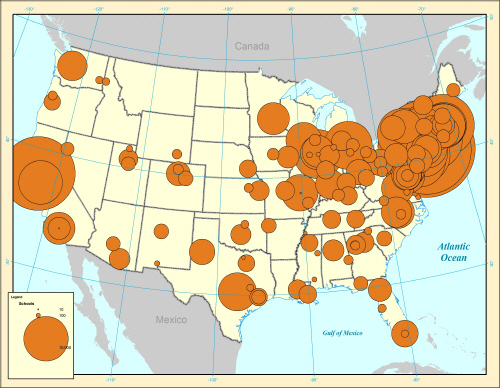Relationship to Geography
Back to Table of Contents | Back to FindingsKey Points
- Distance from major metropolitan areas and from New York City shows only a weak inverse correlation with news coverage, suggesting those institutions in the New York Time's backyard do not receive substantially greater coverage.
- Distance to the nearest large city (PMSA) has a similar correlation.
Discussion
Even national-stature newspapers tend to offer greater coverage to events that occur closer to them. (Myers & Caniglia, 2004) In the case of the New York Times, institutions located closer to the city would therefore seem to have a substantial advantage over those in the Midwest. Figure 1 shows the total number of news articles mentioning each school from 1945 to 2005. Institutions with multiple campuses are assigned to the location of the campus closest to a major metropolitan area. At first glance, the map seems to show a strong bias towards coverage of the East Coast. However this is also the location of most Research Extensive institutions and when factoring in the actual distance of each institution in statute miles from New York City, only a very weak correlation is found.

Figure 1 - Total number of New York Times articles mentioning each research university 1945-2005
News volume has a Pearson correlation of r=-0.21 with both distance in statute miles to New York City and with distance to the nearest US Census Bureau Primary Metropolitan Statistical Area (PMSA). PMSAs are used to test the hypothesis that distance to a large city may matter as much distance to New York City: an institution located in a large city like Chicago might receive greater coverage in Chicago's high-circulation press like the Chicago Tribune, which in turn, might lead to greater coverage in the New York Times. Front page volume is correlated at r=-0.21 for PMSA distance, and r=-0.14 with distance to New York City.
When public and private universities are separated, public institutions show no correlation of volume with distance from New York City, and only a minor correlation of distance to the nearest PMSA (r=-0.19). Front page coverage is correlated at r=-0.16 with distance to nearest PMSA and has no measurable correlation with distance to New York City. Private institutions show a correlation of r=-0.24 with PMSA distance and r=-0.30 with distance from New York City. However, just two public institutions (SUNY and City University of New York) are located in New York State, while 8 of the 48 private institutions are based there. The top two private institutions with the greatest Times coverage (Columbia University and New York University) are both based in New York City itself, suggesting that this correlation may be partially skewed.
At best, private schools in close proximity to New York City receive greater coverage than those further away, while public institutions closer to major metropolitan areas receive greater coverage, but the effects are extremely small. Geographic location therefore has an extremely weak correlation with coverage, suggesting that the location of an institution and its proximity to New York City and to neighboring metropolitan areas has little relationship to its coverage in the New York Times.
References
- Myers, Daniel & Caniglia, Beth Schaefer. (2004). All the Rioting That's Fit to Print: Selection Effects in National Newspaper Coverage of Civil Disorders 1968-1969. American Sociological Review. 69(4). pp. 519-543.


